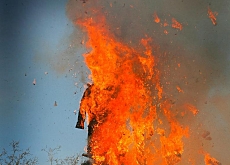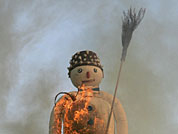Spring explodes into life in Zurich

Zurich has rung in the spring with its traditional Sechseläuten (six bells) festivities, culminating with the symbolic burning of the Böögg snowman.
It took 12 minutes and nine seconds for the snowman’s head – loaded with explosives – to blow up on Monday, forecasting a “moderate” summer.
According to tradition, the quicker the Böögg explodes, the better summer will be. Over the past ten years, the average time for the Böögg to blow his top has been 14 minutes.
However, the national weather office MeteoSchweiz poured cold water on the Böögg on Monday, saying its predictions didn’t stand up to scientific analysis.
“Why should a burning cotton snowman possess good qualities for making predictions?” questioned a report by Daniela Schmuki and Andreas Weigel.
According to MeteoSchweiz it all depends on how the Böögg’s pyre is constructed, the dampness of the wood, the weather on the day and above all the number of accelerants used to get the fire going.
Although the snowman accurately predicted the 2003 summer heat wave – it exploded after a mere 5.7 minutes – on other occasions it has been well off the mark and there is little evidence that the Böögg is sensitive to global warming.
In 1971 it exploded in just 5.0 minutes – the fastest time since 1965 – but the average temperature over the summer was a middling 16.8 degrees Celsius.
There have been two occasions since 1965, in 1970 and 1988, that the Böögg has needed more than 40 minutes to go off, theoretically promising a miserable summer. However, both years had average summer temperatures of 16.8 and 16.9 degrees Celsius respectively.
Execution of winter
This year the pyre was lit at six o’clock on the dot by Joachim Eder, a member of the cantonal government of Zug, this year’s “guest canton”.
Tens of thousands of spectators were on hand to follow the symbolic execution of winter.
Beforehand, members of Zurich’s 26 guilds paraded through the old town in period costume and glorious sunshine.
Also taking part in the festivities were celebrities from Swiss politics, economics and culture.
Swiss President Micheline Calmy-Rey and Justice Minister Christoph Blocher joined the parade, as did UBS boss Marcel Ospel, actor Marco Rima, captain of the Swiss national football team Alex Frei and German former footballer Franz “the Kaiser” Beckenbauer.
Böögg theft
Although it only predicted a moderate summer, at least the Böögg made it to the pyre this year. In 2006 a group of leftwing militants stole the original giant cotton snowman just before its big day.
In a midnight raid they smashed a window of the garage where it was stored and left a chocolate Easter bunny and a hammer and sickle emblem in its place.
The group claiming responsibility for the theft said the 3.5-metre tall snowman “had had enough of putting its head on the line for capitalists”.
The snowman had never been stolen before, although plans had been drawn up to nab him during student unrest in the 1980s. Police were able to avert the theft at the last minute thanks to a tip off. A stand-in Böögg ended up being blown up.
swissinfo with agencies
The Sechseläuten festival in its current form dates back to 1867.
It derives its name from the fact that at the spring equinox the bells of Zurich’s main cathedral would toll vespers again at six o’clock to announce the end of the working day.
In winter time the working day lasted only until five o’clock due to early dusk.
Sechseläuten is run by Zurich’s guilds.
The city’s guilds are run as private social clubs with a total membership of around 3,500.
The earliest guilds were founded in 1336 and played a key role in Zurich life for more than 500 years.
They began to lose their economic influence in the 1830s.

In compliance with the JTI standards
More: SWI swissinfo.ch certified by the Journalism Trust Initiative











You can find an overview of ongoing debates with our journalists here . Please join us!
If you want to start a conversation about a topic raised in this article or want to report factual errors, email us at english@swissinfo.ch.